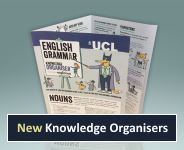Genre of Newspaper Articles
Goals:
- Identify and analsye the discourse features of newspaper articles
- Identify and analsye the register features of newspaper articles
- Apply these features in writing
Lesson Plan
Before this lesson, you may want to complete the lesson An Introduction to Genre, so that learners are familiar with the key terms discourse structure and register
Please check if there are any hand outs at the bottom of this page and print in advance.
Warmer
Use the bulletpoints to introduce the topic and activate the pupils' prior learning. Circulate to monitor the discussion. You could use mini-whiteboards to share/check their answers for the third point.
Activity 1
Explain that learners must work in pairs or small groups. Hand out the printed articles. Learners read Article A and then discuss the bulletpoints. Again, try using mini-whiteboards to share answers. Hopefully, learners will start to notice language and structural features as these are the focus of the rest of the lesson.
Activity 2
Ask learners to recall the meaning of discourse structure and register features. They should be familiar with these terms from the introductory lesson.
Ask learners what are the main elements they exepect to see in a newspaper article. They should be able to come up with a list of several features such as headlines etc., and to discuss what order they appear on the page.
Next, try the mix and match activity as a whole class. First, put the capitalised elements in order from top to bottom i.e. HEADLINE, DATE & BYLINE etc. Then, match the element to what it contains i.e. HEADLINE - (Announces topic). Drag and drop the cards next to each other to connect. Double click to break apart.
A typical order could be HEADLINE, DATE & BYLINE, LEAD, MAIN EVENT, BACKGROUND, CONSEQUENCES and COMMENT. The last three elements can appear in different orders or be repeated depending on the article.
After this, have the learners look back at Article A and label the elements of discourse structure. Use the Labelled Articles handout, so learners can check their answers.
To finish, pose the question: why are newspapers articles organised in this way? Accept any equivalent answers.
Activity 3
Now, change the focus to the register features of the text. Ask learners to read the text again, this time highlighting or underlining any words or phrases that seem important to communicate to the reader. Give learners time to attempt this and to discuss the bullet-points. If time allows, share any interesting points the learners have found.
Show the learners the two examples in the next slide. Ask them what is unusual about the grammar of each. Use the hints to help after a few minutes.
Each of these examples are missing typical elements of grammar we would expect in complete sentences written in Standard English. For each example, learners try rewriting as full sentences, and then explain why the newspaper is written in the original style.
Activity 4
Learners now look at Article B and answers questions 1-3 in pairs or groups. Based on their analysis of Article A, they should be able to complete these activities more independently. Learners can check their answers by comparing with other groups and/or as a whole class. Use the Labelled Articles handout to check discourse features.
In the same way as Activity 3, learners rewrite Article B's Headline and Lead to demonstrate how these are more examples of incomplete sentences used in newspaper articles.
Activity 5
Finally, students can apply this new knowledge in their own writing. Follow the instructions and use the Writing an Article handout.
Welcome!

Englicious is totally free for everyone to use!
But in exchange, we ask that you register for an account on our site.
If you’ve already registered, you can log in straight away.
Since this is your first visit today, you can see this page by clicking the button below.
- Printer-friendly version
- Log in to view or leave comments

